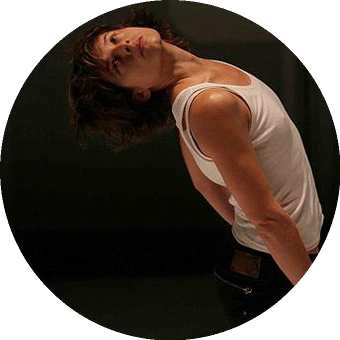La Sisyphe - Presse
Ballet Dancing Takes a New Shape in Brest (Antipodes festival)
(…) A panorama of young creation at the Antipodes festival (…)No bounds. Les Sisyphe by Julie Nioche is a frantic race for dear life, while flowers and animals are wallflower on a revolving screen. Like a training boxer, Rachid Ouramdane skips with a rope till he drops with exhaustion. Julie Nioche takes over and starts running on the spot, out of breath. The show knows no bounds, freely and boldly performed with the Doors’ The End in the background. (…)
The hypothesis of renouncement
Julie Nioche is the choreographer of an enigmatic piece, at the junction of genders, as well as of the human and the animal worlds, which opens at the end. There is not only one Sisyphus, condemned to ceaselessly rolling a rock to the top of a mountain, whence the stone would fall back of its own weight, but two Sisyphus. One is a male. And the other is a female. They both appear in a circular space throwing fragments in the periphery. The gaze peers upon the animal world, but also upon the vegetable one. All the possibilities of dancing are exhausted, as « The End » by Jim Morrisson is to be heard. Les Sisyphe: under the influence of Julie Nioche’s enigmatic piece, we could make the hypothesis of renouncement. We must renounce deciding whether this work is a success or a failure, and also give up defining its meaning, and have to be content with observing, recording and willingly accompany the performance until the end, while we get lost in its gaps. This is what it calls attention to. Gaps here are openings. First gap: a setting emphatically cut up by the unceasing, circular race of a screen controlled by an auto-rolling arm on a perfectly circular path. Rejected on the margins by this slow whirlwind comes Rachid Ouramdane’s dance, who looks like a hunk in his leather jacket, but look here, he is also very girlishly skipping with a rope at the far end of the stage. We can hear "The End" in its feminine version sung by Nico. Second gap: the images on the screen, full of fur and blood, come from an animal world which has been “scalpelized” by man’s world, and more particularly by the photographer Hervé Thoby. Nothing makes sense, at least immediately. Only a strange suspicion remains: come to think of it, it seems that the cultural constructs of genders, but also of the human and the animal worlds share some obscure, essentialist foundation. This should be discussed. Meanwhile, the vegetable world, in blossom, takes over on the screen. But there suddenly comes a flash: Ouramdane, who looks very virile, has taken off his pants, and rises there in underpants, perched on animal hooves. His dance has turned frail, with a shadow of poised femininity slightly streaking the space, both elusive and substantial, in short, precious. A new gap: Ouramdane leaves the stage to let Julie Nioche appear, who is very feminine and doll-like. She switches off the screen. No more circle. No more images. Dressed like a tennis player, she is all white against a white background, facing us. This conveys an impression of extreme plasticity. Another dance starts, stubborn, implacable and suffocating. It is a dance of waste and exhaustion. She runs, jumps on the spot, and mimics all sorts of dances. This implacable stubbornness is surprising, given the girlish pout of the dancer. Even concepts can be killed. And even a whole trend of dance, or of non-dance. Whatever. We then hear "The End" sung by Jim Morrisson in its integral, original and masculine version. You don’t know what to think of all this. But still you want to write about it.

